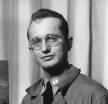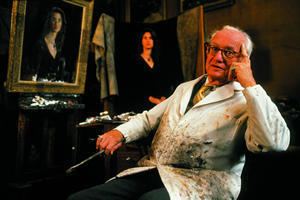Nationality American Known for Painting | Name William Draper Siblings Clare Hill Draper, Jr | |
 | ||
Full Name William Franklin Draper Died October 26, 2003, New York City, New York, United States Parents Mathilda Engamn Draper, Clare H. Draper Education Harvard University, Pomfret School, National Academy Museum and School | ||
William Franklin Draper (December 24, 1912 – October 26, 2003) was lieutenant commander in the United States Navy, and an American painter.
Contents
Early life

Draper was born in Hopedale, Massachusetts on December 24, 1912. His parents were Clare H. Draper and Mathilda Engamn Draper, and his brother was Clare Hill Draper, Jr. After first studying piano, he decided to instead choose painting as his career. Draper attended the Pomfret School in Connecticut, and later Harvard University. After Harvard, he attended the National Academy of Design in New York, and the Cape Art School in Massachusetts. Following his education, he went to Spain to study briefly, and then moved to France, where he attended the Grand Cahumiere. In 1937, he studied sculpture with George Demetrius, a Boston sculptor, and Jon Corbino in New York.
Naval career
In 1942, Draper entered the Naval Reserves as a lieutenant (junior grade). After his initial training, Draper was assigned to the Anti-Submarine Warfare Unit in Boston. Following his service in Boston, he transferred into the Naval Art Section, and was dispatched to Alaska, where he spent nearly half a year painting in the Aleutian Islands. He was in Amchitka when the Japanese invaded during World War II, and his paintings depict the attacks, as seen from his close-range foxhole. Draper painted while dealing with the wind and Arctic weather, which made painting difficult, as he had to wear gloves to keep from getting frostbite.
After Draper returned from Alaska, he was requested as the artist for the portrait of Rear Admiral J.R. Beardall, then Superintendent of the United States Naval Academy. Following the completion of the portrait, he served in a variety of other areas in the Pacific, and commissioned to paint portraits of several other admirals.
After the Bougainville Campaign, Draper was assigned to the USS Yorktown (CV-10), and while on duty, painted the series of air attacks on Palau, the landings at Hollandia, and the airstrikes on Truk island. Draper also covered invasions of Saipan and Guam aboard the USS Tennessee (BB-43). During his tour on the Tennessee, the ship was hit three times by enemy fire, and they were forced to land at Guam.
Draper was awarded the Bronze Star for his Naval services, and left the Navy in 1945 as a Lieutenant Commander. Returning to painting, he became a well-known American artist, with subjects ranging from John F. Kennedy (painted in 1962), Richard M. Nixon, (1981), the Shah of Iran (painted in 1967), James Michener (1979), Henry Kaiser, and Dr. Richard E. Winter (1992).
In 1999, Draper received a lifetime achievement award from the Portrait Society of America.
Draper died on October 26, 2003 at the age of 90.
